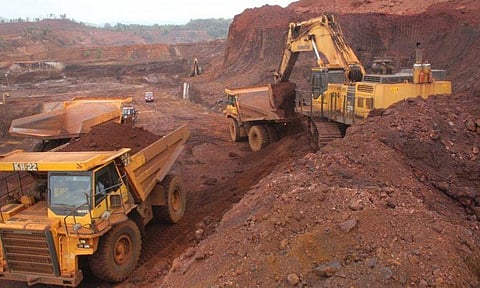The golden mines: A study by Goa University reports traces of gold in state's iron ore
A study conducted by Goa University reveals a new fact that will change the fate of Goa's long-ignored mining industry. The research by Sujata Dabolkar and Dr Nandakumar Kamat of the Botany Department reveals traces of gold in Goa's iron ore. Read on to know more about this research work published in the latest edition of the Journal of Geosciences Research.
First research to report presence of gold in Goa's iron ore mines
[rebelmouse-proxy-image https://media.rbl.ms/image?u=%2Fmigration_catalog%2Farticle22533594.ece%2FALTERNATES%2FLANDSCAPE_1200%2FGoamining812162f1331137f&ho=https%3A%2F%2Fwww.thehindubusinessline.com&s=805&h=79282d236efd9b3d37f763134dffbe1d9bcf206b336ca5d88b77440b7a0f307d&size=980x&c=3911870153 photo_credit="" pin_description="" dam="0" site_id=20074994 caption="" photo_credit_src="https://www.thehindubusinessline.com/migration_catalog/article22533594.ece/ALTERNATES/LANDSCAPE_1200/Goamining812162f1331137f" crop_info="%7B%22image%22%3A%20%22https%3A//media.rbl.ms/image%3Fu%3D%252Fmigration_catalog%252Farticle22533594.ece%252FALTERNATES%252FLANDSCAPE_1200%252FGoamining812162f1331137f%26ho%3Dhttps%253A%252F%252Fwww.thehindubusinessline.com%26s%3D805%26h%3D79282d236efd9b3d37f763134dffbe1d9bcf206b336ca5d88b77440b7a0f307d%26size%3D980x%26c%3D3911870153%22%7D" expand=1]
According to reports, this is the first research conducted in Goa that analyses the presence of gold in the ore extracted from Goa's iron ore mines. Notably, the iron-ore mines in Goa were shut down in 2018 in line with the Supreme Court's order due to irregularities in the mining lease renewal processes.
"Detection of gold in the samples has been reported. The gold concentration ranges from 7.71-13 ppm indicating the auriferous nature of Goa's iron ore. There needs to be further research on neglected auriferous iron ore of Goa," read the research paper. Adding that it is the first such report on "the detection of gold from the BHQ (banded hematite quartzite) and the BMQ (banded magnetite quartzite) of Goa."
The history of iron ore in Goa
[rebelmouse-proxy-image https://media.rbl.ms/image?u=%2Fin-mine_1.jpg&ho=https%3A%2F%2Fs.w-x.co&s=647&h=45847b0f1b914412da09fd0b8c2623ad7114f58490a0458db6d7c86b6abbbb2b&size=980x&c=2610611059 photo_credit="" pin_description="" dam="0" site_id=20074994 caption="" photo_credit_src="https://s.w-x.co/in-mine_1.jpg" crop_info="%7B%22image%22%3A%20%22https%3A//media.rbl.ms/image%3Fu%3D%252Fin-mine_1.jpg%26ho%3Dhttps%253A%252F%252Fs.w-x.co%26s%3D647%26h%3D45847b0f1b914412da09fd0b8c2623ad7114f58490a0458db6d7c86b6abbbb2b%26size%3D980x%26c%3D2610611059%22%7D" expand=1]
Interestingly, the mining exploration for iron ore was initiated in Goa in the Portuguese era. For exploration and exports, the cash-strapped Portuguese empire assigned hundreds of mining leases to its colonial subjects in Goa. Out of these, around 100 were operational till 2012, before the first ban by the Supreme Court owing to the ₹35,000 crore mining scam.
From 4.36 tons of ore in 1951, the excavation and export of iron ore had climbed up to around 50 million tons in early 2010 leading to the export of around 880 million tons of iron ore from Goa to markets in China, Japan, Taiwan, South Korea, among others. While this ban was revoked after two years, the second ban on the industry was imposed in 2018.
Scope for confirmation by GSI, IIT & other institutes
[rebelmouse-proxy-image https://media.rbl.ms/image?u=%2Fsites%2Fdh%2Ffiles%2Farticleimages%2F2022%2F02%2F20%2F2019-08-05t122714z1590160328rc195b18e960rtrmadp3nickel-indonesiajpg-1083300-1645328710.jpg&ho=https%3A%2F%2Fwww.deccanherald.com&s=258&h=974fc138822f5eae3b3655e447c98e9f86452332b28a9cbc9e5156d7607c3905&size=980x&c=2550620061 photo_credit="" pin_description="" dam="0" site_id=20074994 caption="" photo_credit_src="https://www.deccanherald.com/sites/dh/files/articleimages/2022/02/20/2019-08-05t122714z1590160328rc195b18e960rtrmadp3nickel-indonesiajpg-1083300-1645328710.jpg" crop_info="%7B%22image%22%3A%20%22https%3A//media.rbl.ms/image%3Fu%3D%252Fsites%252Fdh%252Ffiles%252Farticleimages%252F2022%252F02%252F20%252F2019-08-05t122714z1590160328rc195b18e960rtrmadp3nickel-indonesiajpg-1083300-1645328710.jpg%26ho%3Dhttps%253A%252F%252Fwww.deccanherald.com%26s%3D258%26h%3D974fc138822f5eae3b3655e447c98e9f86452332b28a9cbc9e5156d7607c3905%26size%3D980x%26c%3D2550620061%22%7D" expand=1]
The research paper states, "Despite (being) endowed with chemically the most diverse and creative Archean rocks in the WDC (Western Dharwar Craton), Goa still lacks an intensive knowledge-based sustainable mining policy. There is further scope for confirmation of gold by Geological Survey of India, IITs and other research institutes of India."
According to the researchers, both the government sector as a regulator and private mining companies lack knowledge of systematic geochemical evaluation of iron ore. With the main focus on excavation and export strategy, both parties completely overlooked the gold mineralisation of these ores.
"There is a lot of scope to carry out work on the metallogeny of gold. Biogeochemical cycling of gold can be studied including the investigations on the occurrence of vermiform gold, phytoform gold, gold from the alluvial deposits, sediments and laterites," reads the study.
-with inputs from IANS.
To get all the latest content, download our mobile application. Available for both iOS & Android devices.

